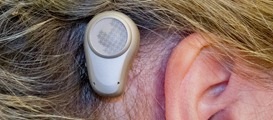Hearing Aids
Appointment Request
Assistive Listening Devices (ALDs)

ALDs enhance hearing in places like theatres and lecture halls. They also enable connections to audio sources for music and TV.
If you have hearing loss, it is likely hearing aids will be a tremendous help to you in your daily life. But what about those special situations when your hearing aids aren’t quite enough? Special devices called assistive listening devices (ALDs) are useful helpers for listening to conversations on the phone, watching favourite shows on television, watching performances or speakers in public places and classrooms and even waking to an alarm clock in the morning or hearing the doorbell.
There is a surprisingly large array of ALDs on the market today, and many are geared towards very specific needs. Some of these devices are made to work specifically with certain hearing aids while others are stand-alone and can be helpful even if you don’t yet wear hearing aids.
CapTel-captioned phone
Ideal for people with some degree of hearing loss, the Captioned Telephone, or CapTel, works like any other telephone with one important addition:
It displays every word the caller says throughout the conversation. CapTel phone users can listen to the caller, and can also read the written captions in the CapTel’s bright display window.

You dial the other person’s number, exactly the same way as with any other telephone. As you dial, the phone automatically connects to a free captioning service. When the other party answers, you hear everything they say – just like a traditional call. The captioning service transcribes everything they say into captions, so you can read it too.
The way you see captions on incoming calls depends on which CapTel model you use. With some models, people call your number directly like any other phone call. With other models, callers dial the captioning service first and enter your phone number.
For more information please visit https://www.captel.com/captel/.
Assistive listening devices for televisions
When you have trouble clearly understanding or hearing the television, watching your favorite shows can become a chore. Turning up the television isn’t always the best option since it can make sound distorted and even more difficult to understand. And, when you’re watching TV with others, maxing out the volume isn’t always a popular option. There are ALDs that can work for you whether or not you already wear hearing aids.

It is possible to watch television at a volume that’s comfortable for you both!
Many modern hearing aids are now equipped with wireless capabilities to allow for personal adjustment of the television volume and streaming of the sound directly to your hearing aids through Bluetooth-enabled accessories. Not only will you hear the TV more easily, you can keep the volume comfortable for those without hearing loss watching with you.
Some television amplifiers work even without hearing aids.
FM systems
One of the biggest challenges for people with hearing loss is hearing in the presence of background noise, particularly in classrooms or public venues. These difficulties happen when the ratio of the speech signal from the teacher or speaker isn’t loud enough compared to the background noise. This ratio is called the signal-to-noise ratio (SNR) and improving it can make a big difference in hearing and understanding speech in these challenging places.
While not a new technology, an FM system is a dependable and very effective wireless technology that makes it easier to understand what others are saying in noisy situations, like classrooms or public events. The FM system consists of a transmitter microphone used by the person speaking in front of an audience and a receiver used by the hearing aid wearer. An FM system ensures the speech signal is delivered directly to both hearing aids. There are options for completely blocking out background noise while wearing it or allowing an optimal combination of speech and some background noise. These systems are widely used in schools to help children with hearing loss achieve their educational goals but they are also helpful for adults in many situations.
Alerting devices
Most ALDs help make listening easier, but some also help you stay connected to what is going on around you and improve your safety. These alerting devices rely on amplified sounds, visual cues and even vibrations to alert you to sounds in your environment.

The Sonic Alert clock uses audible signal and vibration to wake you.
Some examples of alerting devices include vibrating alarm clocks to help you start your day on time, doorbell alerts that use flashing lights to let you know a visitor is at your door and vibrating and lighted smoke and carbon monoxide detectors. These devices can give you peace of mind and help keep you, even during those times when you may not be wearing your hearing aids.
Hearing aid technology is impressive and can be a big help for people with hearing loss. However, if you have unique needs that aren’t addressed by your hearing aids or if you aren’t yet ready for hearing aids, assistive listening devices can be the answer.
Our Locations
Mount Waverley
(Pinewood Shopping Village)
- Level 1, 407 Blackburn Road
Mount Waverley, VIC 3149 - 03 98867157
- contact@allearshearing.com.au
- Monday: 9:00am – 5:00 pm
Tuesday: 9:00am – 5:00pm
Wednesday: 9:00am - 5:00pm
Thursday: 9:00am – 5:00 pm
Friday: 9:00am - 5:00pm
Saturday: Only on request. Weekend charges apply
Bentleigh East
- 869 Centre Road
- Bentleigh East , VIC 3165
- 03 98867157
- contact@allearshearing.com.au
- Wednesday : 10:30 am – 5 pm
Yarra Junction
- Yarra Junction Arcade
Shop 4/2456 Warburton Hwy
Yarra Junction, VIC 3797 - 03 98867157
- contact@allearshearing.com.au
- Tuesday: 9:30 am - 5:00 pm
Friday: 9:30 am - 5:00 pm



 View on Map
View on Map